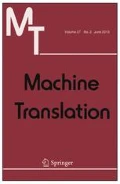Abstract
This paper examines differences between two professional translations into English of the same Spanish newspaper article. Among other explanations for these differences, such as outright errors and free variation, we find a significant number of differences are due to differing beliefs on the part of the translators about the subject matter and about what the author wished to say. Furthermore, these differences are consistent with divergent global views of the translators about the likelihood of future events (earthquakes and tidal waves) and about (rational or irrational) reactions of people to such likelihood. We discuss the requirements for a pragmatics-based model of translation that would account for these differences.
Similar content being viewed by others
References
Ballim, A. and Y. Wilks: 1990, Artificial Believers: The Ascription of Beliefs. Lawrence Erlbaum Associates, Hillsdale, NJ.
Bar-Hillel, Y.: 1960, ‘The Present Status of Automatic Translation of Languages’, Advances in Computers 1, 91–163.
Barnden, J., S. Helmreich, E. Iverson, and G. Stein: 1994, ‘An Integrated Implementation of Simulative, Uncertain and Metaphorical Reasoning about Mental States’, Proceedings of the 4th International Conference on Principles of Knowledge Representation and Reasoning, Bonn, Germany, pp. 27–38.
Charniak, E.: 1978, ‘With Spoon in Hand this Must Be the Eating Frame’, in Proceedings of the 2nd Conference on Theoretical Issues in Natural Language Processing, Urbana-Champaign, Illinois, pp. 187–193.
Farwell, D. and S. Helmreich: 1993, ‘Insights into Communicative Intent from Pragmatics based Translation Equivalence’, presented at the 7th Annual Southwestern Cognitive Science Conference, Tucson, AZ, March 1993.
Farwell, D. and S. Helmreich: 1995, ‘This Is Not a Bedroom Farce: Pragmatics and Translation’, in Contributed Papers of the 4th International Colloquium on Cognitive Science, Donostia, Spain, pp. 73–82.
Farwell, D. and S. Helmreich: 1996, ‘Ground Floor? First Floor? Going Up’, presented at the 5th International Pragmatics Conference, Mexico City, Mexico, July 1996.
Farwell, D., S. Helmreich, W. Jin, M. Casper, J. Hargrave, H. Molina-Salgado, and F. Weng: 1994, ‘Panglyzer: Spanish Language Analysis System’, in Technology Partnerships for Crossing the Language Barrier: Proceedings of the First Conference of the Association for Machine Translation in the Americas, Columbia, Maryland, pp. 56–65.
White, J., T. O'Connell and F. O'Mara: 1994, ‘The ARPA MT Evaluation Methodologies: Evolution, Lessons, and Future Approaches’, in Technology Partnerships for Crossing the Language Barrier: Proceedings of the First Conference of the Association for Machine Translation in the Americas, Columbia, Maryland, pp. 193–205.
Author information
Authors and Affiliations
Rights and permissions
About this article
Cite this article
Helmreich, S., Farwell, D. Translation Differences and Pragmatics-Based MT. Machine Translation 13, 17–39 (1998). https://doi.org/10.1023/A:1008062303478
Issue Date:
DOI: https://doi.org/10.1023/A:1008062303478




